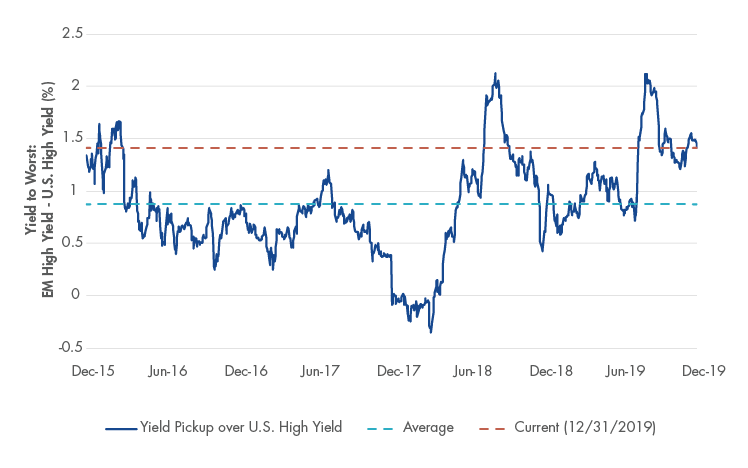Where to Find Value in High Yield Bonds
29 January 2020
Read Time 5 MIN
High yield bond spreads and yields have steadily declined since their most recent peak in early 2016, notwithstanding a small but meaningful widening in 2018. This reflects slow but generally steady economic growth globally, and a continued search for yield. Although yields are tight by historical standards, comparisons between different segments of the global high yield market reveal potential opportunities. For example, although absolute yields of emerging markets high yield corporate bonds have tightened in recent years, we believe the yield pickup over U.S. high yield compares favorably from an historical perspective. The excess yield of emerging markets over U.S. high yield corporate bonds currently exceeds the levels of 2016, when credit spreads overall peaked, as well as the average level since then.
Attractive Yield Pickup for Emerging Markets High Yield Over U.S. High Yield

Source: ICE Data Indices. Data as of 12/31/2019
We believe this relative value opportunity is perhaps even more attractive in light of the robust credit fundamentals the asset class exhibits, which compare favorably to U.S. high yield corporates – from both a static and directional point of view. For example, interest coverage ratios among emerging markets high yield issuers were nearly 20% higher than U.S. counterparts, while net leverage was 20% lower, and the 2019 default rate among emerging markets high yield issuers was lower than the U.S. high yield default rate. Further, the asset class has a higher tilt towards higher rated high yield bonds. Continued dovish central bank policy, thawing U.S./China trade tensions and an uptick in global growth may help to offset macro uncertainty, while larger strategic allocations from global investors and favorable net issuance supply trends may also provide support.
For more on emerging markets bonds exposure in the current environment, watch this video with Fran Rodilosso, Emerging Markets Debt: Yield and Diversification.
Related Insights
IMPORTANT DEFINITIONS & DISCLOSURES
This material may only be used outside of the United States.
This is not an offer to buy or sell, or a recommendation of any offer to buy or sell any of the securities mentioned herein. Fund holdings will vary. For a complete list of holdings in VanEck Mutual Funds and VanEck ETFs, please visit our website at www.vaneck.com.
The information presented does not involve the rendering of personalized investment, financial, legal, or tax advice. Certain statements contained herein may constitute projections, forecasts and other forward looking statements, which do not reflect actual results. Information provided by third-party sources are believed to be reliable and have not been independently verified for accuracy or completeness and cannot be guaranteed. Any opinions, projections, forecasts, and forward-looking statements presented herein are valid as of the date of this communication and are subject to change without notice. The information herein represents the opinion of the author(s), but not necessarily those of VanEck.
The views contained herein are not to be taken as advice or a recommendation to buy or sell any investment in any jurisdiction, nor is it a commitment from Van Eck Associates Corporation or its subsidiaries to participate in any transactions in any companies mentioned herein. This content is published in the United States. Investors are subject to securities and tax regulations within their applicable jurisdictions that are not addressed herein.
All investing is subject to risk, including the possible loss of the money you invest. As with any investment strategy, there is no guarantee that investment objectives will be met and investors may lose money. Diversification does not ensure a profit or protect against a loss in a declining market. Past performance is no guarantee of future results.
Related Insights
03 May 2024